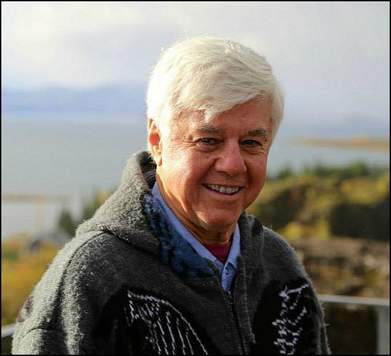In seventh grade geography, Miss Silk, a stern and memorable teacher and principal, used her collection of pull down wall maps to require her students to identify and memorize place names and prominent physical features. Her class was my first and only experience with geography as a K-12 student. In the 1950’s schools in Massachusetts offered very little geography and mastery of facts ruled the day. My next geography courses came in the late 1950’s as an undergraduate enrolled in economic geography and political geography courses taught by a non-geographer. The courses were descriptive and fact oriented with little or no mention of spatial and environmental perspectives, analysis or systems.
I knew nothing of the National Council for Geographic Education until I was in graduate school at Assumption College in Worcester, Massachusetts pursuing a master or arts in teaching degree. My professor was Earl B. Shaw, a past president of NCGE (1949).
He asked his students to read articles from the Journal of Geography that he and others had published. Although he had acquired an encyclopedic knowledge of world regions, he also had interests in topics such as The Geography of Baseball (Journal of Geography, February 1963). He was a fine teacher and I was impressed with his range and depth of knowledge.
After completing my masters degree program in 1964 I began teaching in my hometown junior high school in Spencer, Massachusetts. This is where I had learned basic geography facts from Miss Silk. Possessing a general social studies teaching certificate, I was deemed prepared to teach seventh grade geography and eighth grade civics. I did not feel ready to teach geography based on the slender reed of three college courses and a six-week student teaching stint in United States history.
I was the only geography teacher in the school system and had a lot of catching up to do. It was sink or swim—learn geography at the same time as learning how to teach junior high school students. Classes were large with 35-40 students and no experienced geography teacher colleagues to consult. I was engaged in a trial and error process with plenty of errors to reflect upon. Professional development opportunities were sparse so I took a series of regional geography courses at Worcester State College, a traditional teacher preparation school, to enhance my knowledge. The courses were useful for acquiring information but did not help me teach geography to young students. The courses offered lots of facts to master but not much in the way of conceptual frameworks to organize the facts gained.
After four years teaching junior high school students, I entered a one-year graduate fellowship program in geography and history at Clark University in Worcester, Massachusetts. Unexpectedly, that year turned into four and a PHD in Geography. The experience at Clark was multi-disciplinary with seminars in geography education and opportunities to engage with teachers and students in local schools, including working for one year in an alternative public high school. My perspectives on geography and geography education expanded and transformed. At Clark graduate students were encouraged and funded to engage in professional activities. I attended and presented at national geography conferences. There, I met people from around the country and many were active members and officers in NCGE.
Upon completing my doctoral degree in 1973 I accepted a joint appointment in geography and education at Virginia Tech. I taught several geography courses, courses in social foundations of education and worked each week with an off campus alternative school. I was totally immersed with colleagues in building a geography department while simultaneously reflecting on a wide range of education issues. I became more active in professional organizations through presenting and serving in various capacities. My activities with NCGE expanded from serving on awards committees and nominating committees to election as an Executive Board member in 1984 and later as President in 1989.
A major highlight of that period was serving as an NCGE member on the NCGE/AAG Joint Committee on Guidelines for Geographic Education (1983-1984). I was fortunate to share that rewarding and productive experience with Dick Boehm, Jim Kracht, Dave Lanegran, Jan Monk and the late Sam Natoli. This effort marked the first time that the Association of American Geographers and the National Council for Geographic Education collaborated on developing geography guidelines for K-12 schools. The result was the Guidelines for Geographic Education (1984) presenting the Five Themes of Geography that later became widely adopted among teachers, curriculum writers and publishers. Five thinking skills also were presented but were overshadowed by the widely popular five themes.
The formation of the Geographic Education National Implementation Project (GENIP) followed soon after the Guidelines were published. GENIP brought together the Association of American Geographers, the American Geographical Society, the National Council for Geographic Education, and the National Geographic Society in a cooperative venture to implement the Guidelines and shape the future of geography education. I was pleased to serve for six years as an NCGE representative and Treasurer of GENIP.
Notably, important elements of the Guidelines live on in succeeding geography education related publications including Geography for life: National geography standards (1994 and 2012), the Road Map for 21st Century Geography Education Project (2013) and The College, Career, and Civic Life (C3) Framework for Social Studies State Standards (2013). I appreciated the opportunity to work on these projects with so many capable colleagues.
I realize that over the years being an active NCGE member brought invitations to participate in these and other geography education projects. I consider NCGE as my home base national professional organization. I know that I would have had far fewer opportunities to join in such enjoyable joint learning adventures without my NCGE colleagues and friends supporting me. I take this opportunity to thank you—and you are far too many to name here. You know who you are.
In closing, I must affirm that a significant and substantial part of my geography education journey is with Virginia Geographic Alliance colleagues, extending from 1988 to the present. I served as VGA co-coordinator with Joe Enedy from 1992 through 2013 and can recount numerous delightful experiences with teachers at all grade levels as we explored Virginia by van, bus and train, the United States and Canada by train, bus and boat, and Ecuador and Brazil by plane, bus and boat…and all the while sharing autobiographical maps and sense of place reflections. We all agreed that, “ There is no substitute for being there.”
I often wonder what Miss Silk would think of the changes in me and in geography education since I was a student in her class in 1952. She might share the sentiment in an observation attributed to Soren Kierkegaard. “Life can only be understood backwards; but it must be lived forwards.”
Bob Morrill


